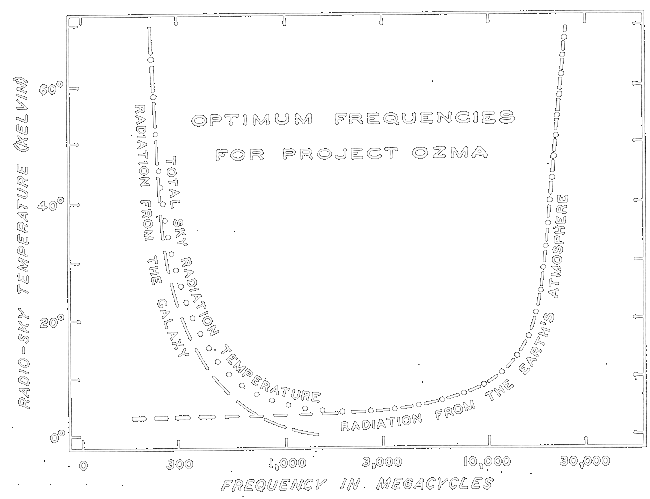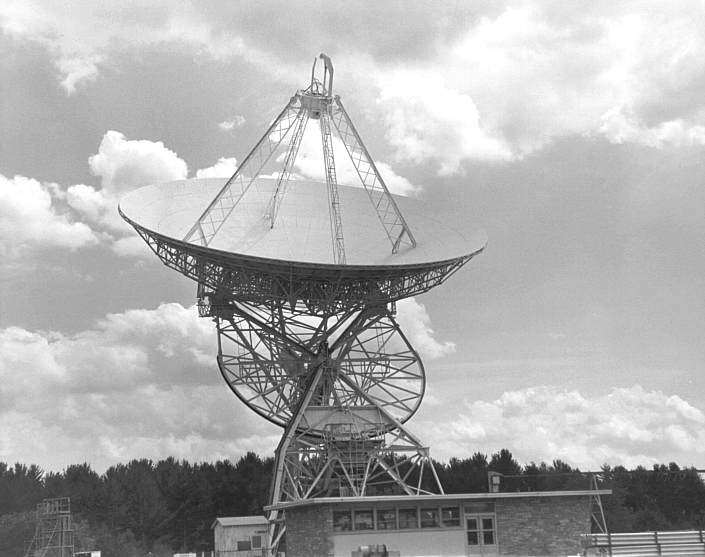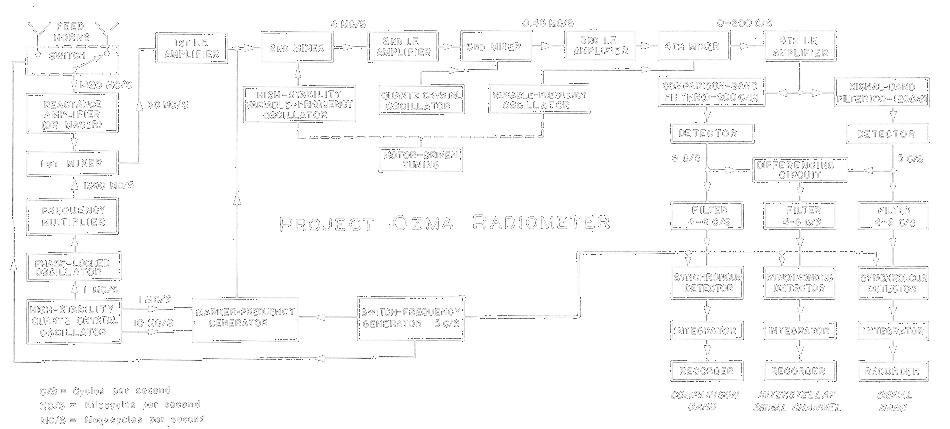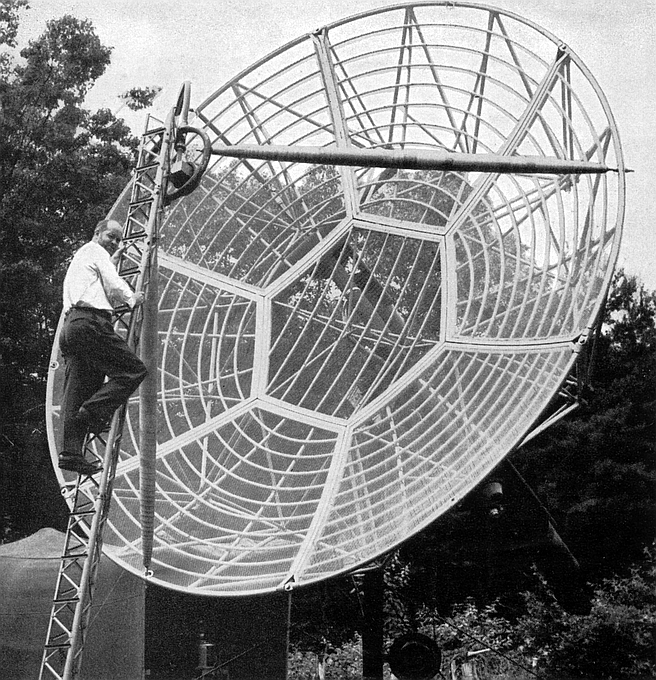|
Speculations on Communications With Other Planet Civilizations - [Project OZMA 1959-1960] BY DANA W. ATCHELY, JR., W1HKK
DURING our lifetime several events have occurred which have had tremendous significance to us all. The first nuclear explosion in 1945 and the Soviet’s Sputnik I are two striking examples. Reception and eventual change of intelligent information with some sort of civilization now in existence on another planet certainly would be an event of tremendous importance to us all. I believe that such an accomplishment appears to be most possible within the next decade. Since this subject should he of utmost interest to all radio amateurs I will attempt in this short article to bring you up to date on the basic premises for such startling speculations and, of more importance, what is being done to bring such an event to reality. Life on other Planets Before embarking on the radio communications involved it is necessary to establish that there is a reasonable probability of life existing on other planets capable of generating radio signals. Although such speculations have been going on for years, within the past three months three excellent articles have been published which put the problem clearly in focus. The first was published in the British journal Nature (September 19, 1959, page 844) by Giuseppe Cocconi and Philip Morrison of Cornell University. This paper was quickly followed by an article in the January, 1960, issue of Sky and Telescope, by Frank D. Drake, “How Can We Detect Radio Transmissions from Distant Planetary Systems”, and another in the January 2, 1960, issue of the Saturday Review by John Lear entitled “The Search for Intelligent Life on Other Planets”. This article is a digest of these three with a few “amateur” type speculations of my own. Concerning life on other planets, the following highly simplified concept is advanced: Stars (such as our sun) are mixtures of hot gases and have been in existence for finite times. It would appear that the formation of planets and eventually “life” is some sort of function of time, temperature, and ingredients. If the proper elements are put in the “pot” and cooked long enough things happen and eventually something like a human could be produced. Billions of years are required to produce intelligent beings from a “potful” of organic molecules. Astronomers have examined the spectral distribution, temperature, and age of many “seeable” stars and have come up with varying estimates of the probability of planets within the vicinity of these stars having some sort of life that could eventually generate radio transmissions. These estimates range from one star in four to as low as one star in a million with such qualifications. These odds have seemed high enough so that at least one qualified organization is getting ready to try to receive such transmissions. An Active Program As far as I can determine the only active program is under the direction of Frank D. Drake of the National Radio Astronomy Observatory at Green Bank, West Virginia. Drake has spent much of his 29 years in radio astronomy. He received his undergraduate training in physics from Cornell and his graduate training, resulting in a Ph.D. in radioastronomy, at Harvard. He states that he has never become a radio amateur because he is “too busy” but he is quite interested in the reaction of the amateur to his program. Drake has proposed a very interesting premise which would indicate that we electronically oriented types are very fortunate to have picked this particular century of centuries to have come into existence since 50 years ago there would have been no place for our talents and 50 years from now electronics as applied to communications will become as pedestrian as a 60 c.p.s. generator. I quote directly from his article. “What search frequency would be best? Consider what might be called the principle of technical perfection. It is only about 50 years since radio communication was invented, yet we have already very nearly achieved technically perfect instruments, and within 50 more years we should have them. By technical perfection we mean that the limits of communication-system sensitivities are not set by deficiencies in the apparatus, such as receiver noise, but by natural phenomena over which man has no control. This is a state in which further improvements in apparatus will not improve the operational results. "A century is only about a hundred-millionth of the age of our galaxy. Thus, on the galactic time scale, a civilization passes abruptly from a state of no radio ability to one of perfect radio ability. If we could examine a large number of lifebearing planets, we might expect to find in virtually every case either complete ignorance of radio techniques, or complete mastery. This is the principle of technical perfection. Our civilization may be one of an extremely small minority in transition between the two possible states - this, in fact, may be the only major feature in which man is unique.
“Therefore, it may be logical to assume that the civilizations we might detect possess complete mastery of radio already. The transmissions we seek will obviously be very powerful ones, in which large information transfer over long distances is being attempted. Frequencies will be chosen for which the natural limitations on performance are least. Two of these limitations are important: galactic radio noise emission, and noise from the planetary atmosphere, if reception from beneath the atmosphere is being attempted. “Both these emissions insert noise into the receiver, and have the same effect as though the receiver itself were noisy. The graph (Fig. 1) shows for the earth the radio-sky temperature produced by each of these sources of noise, and their combined effect. This last would be the excess receiver noise temperature of an otherwise perfect receiver. Obviously, the best frequencies to use for our search are those where this total sky temperature is least. “For instance, from beneath the atmosphere of a planet like the earth, the band from 1000 to 10,000 megacycles per second would be the optimum for reception of long-range transmissions. If, however, reception is being done from above the atmosphere, as the principle of technical perfection and our own success with satellites suggest, frequencies above 10,000 megacycles are also good candidates.” The almost unanimous recommendation for the choice of a “search” frequency is the region around 1420 Mc. (21 cm.). In 1951 Dr. Harold Ewen, then at Harvard, and now the very active president of the Ewen-Knight Corp. in Natick, Mass., discovered that in the vast, cool regions of space there is considerable radiated energy at approximately 1420 Mc. This radiation comes from the collision of neutral, highly kinetic hydrogen atoms which although they have a density of only 1 per cubic centimeter occasionally collide and one collision in eight is of the type that radiates at 1420 Mc. This radiation is strong enough so that depending on the aperture of the dish of the radio telescope, it can be detected at great ranges. Dr. Drake estimates that as many as 15 radio telescopes throughout the world are observing 1420-Mc. outer space radiation on a 24-hour basis. Astrophysicists such as Cocconi and Morrison of Cornell have postulated that since the interest in the 1420-Mc. radiation of cool, interstellar hydrogen is so strong here on earth, scientists on other planets must also be probing this region to learn more about their galaxy. Hence they have suggested that transmissions very near this frequency might be used to contact our earth. Drake, who is also an astrophysicist, and who probably had no real alternate candidate frequency for such a search, has embarked on a very ambitious program on 1420 Mc. which I will cover in the latter part of this article. A Couple of Approaches Before doing so I would like to advance two obvious, but non-astrophysical approaches to the problem. Drake has made the reasonable assumption that some of the most likely civilizations on other planets have long since passed through the critical 100 years of radio development. Is it not logical that a similar critical period exists during which a civilization undergoes the transition from being confined to the ground to baying thorough mastery of the space region within a reasonable distance from his own planet. It would seem to me that some such other planet has long since categorized our earth as a suitable candidate for “civilization brewing” and has been watching us and other suitable planets on a routine, automatic basis from sophisticated radiotelescopes on stable space platforms outside of their own atmosphere. If such is the case, we can make two further assumptions. First, that like any good radio amateur listening for DX, they will transmit back near the frequency they first heard on a regular basis, and, second, that the millimeter wave region which has advantages which I will shortly describe is available to them both for transmission and reception. I believe that most of the earlier transmissions from our earth were confined by the ionosphere due to their relatively low frequency. However, sometime around 1936—1938 enough power was radiated routinely on frequencies above 30 Mc. that some of it escaped to outer space where, depending on the sensitivity of the other civilization’s receiving installation, it may have been heard. The first British coastal radar chain and the Yankee network 49.3-Me. 500-kw. e.r.p. f.m. station W43B on top of Mount Asnebumskit are two good examples of stations that might have gotten “through.” Drake, who has almost completely ruled out the possibility of signals coming from other planets within our solar system, has stated that he will concentrate his initial listening to the regions near the two solar-type stars Tau Ceti and Epsilon Eridani which are 11 light years away. If we assume that the round trip then takes 22 years, it is interesting to note that 1938 + 22 = 1960. Since this might be the big year, on a long-shot basis it might he very worthwhile to listen to the region from 30 to 50 Mc. with suitable arrays pointed toward these stars when the m.u.f. is lower than 30. ‘With the present earth state of the art of receiving equipment plus the lugh background noise (see Fig. 1), we must rely on the transmitters on the other planet being most powerful to overcome our deficiencies. Drake believes that the sought-after-signals will of necessity be narrow band and with no spectacular form of modulation. Doppler shift will be evident due to the relative motion of the receiver and transmitter. This shift plus direction may be the distinguishing characteristics of this signal. Unfortunately, because of previous experience the civilization on the other planet may decide that it is too difficult to try to contact us during our 100 years of transition to radio maturity since during this period they may have to compensate for our lack of an outside-of-atmosphere space platform, plus our inadequate receivers, transmitter, and perhaps unsophisticated correlation detecting schemes. If he does elect to wait until we mature, the first communication will probably not take place at 30 Mc. or 1420 Mc., but more than likely between two outer atmosphere space platforms operating with very high power in the millimeter wave region above 30 kMc. Here we will have the obvious advantages of no atmospheric absorption plus the capability of generating, with relatively small antennae, very high effective radiated powers over very narrow beam widths. In addition, the vast number of megacycles available in this region would provide bandwidths for very fast rate of intelligence delivery per second. However, unless something really new shows up, we will still be inhibited by what now appears to be the remarkably slow speed of light in exchanging such intelligence. Project Ozma Enough of such speculation. Let us return to Drake. With luck in March, 1960, the National Radio Astronomy Observatory in Green Bank, West Virginia, will be listening near 1420 Mc. from an 85-foot telescope such as shown in Fig. 2. The following rule of thumb applies to reception of 1420 Mc. The distance in light years at which strong present-day transmitters can be detected is about equal to the diameter of the parabolic reflector in feet divided by 10. Thus, Drake’s telescope could pick up present-day “earth” style transmitters at a distance of 8.5 light years. The fact that he is concentrating on stars at 11 light years distance implies that he is hopeful that the engineers of the Tau Ceti and Epsilon Eridani planet systems have progressed far beyond our present techniques.
Drake’s project is called Ozma after the beautiful princess of imaginary Oz. His system is quite complex and is described by him in his recent article as follows. “A block diagram (Fig. 3) is given here of the Ozma radiometer, which operates near 1420 megacycles. It is essentially a highly stable narrow-band superheterodyne receiver, which utilizes the principles of both the Dicke radiometer and the d.c.-comparison type (see November 1959, Sky and Telescope).
“Two horns are placed together at the focus of the parabolic antenna, in order to eliminate terrestrial interference to some extent. These horns give the antenna two beams, one to point at the star under study, the other off into space near the star. As the electronic switch connects first one horn and then the other to the receiver, the telescope will look alternately at the star and at the sky beside it. Any radiation from the star will then enter in pulses whose duration is controlled by the switch. The synchronous detectors near the output end of the circuit will respond only to pulses synchronized with the switch, thus detecting only the desired signal. Receiver noise is eliminated, and also terrestrial disturbances. “Interference generally enters a radio telescope antenna through the horns directly, without a reflection from the paraboloid. In that case, both horns should receive the interfering signal with the same strength, and when the switch changes from one horn to the other there will be no change of level iii the interference entering the receiver. As a result, the interference signal is not pulsed, and the synchronous detectors ignore it. “In the present receiver, immediately after the switch there comes a reactance [i.e., parametric] amplifier, to be replaced later with a maser. The amplifier, which gives the radiometer high sensitivity, was built by Ewen-Knight Corp., while the electronic switch was made by H. Hvaturn of NRAO. “The signal then undergoes four frequency conversions, this many being necessary because the final intermediate frequencies are very low, due to the narrow bandwidth requirements. The frequency received by the radiometer is directly dependent on the frequencies of the four oscillators, whose output signals beat with the true signal to produce the intermediate frequencies. In our specifications all four oscillators must hold their frequencies constant to better than one cycle per second on 100 seconds, if the over-all received frequency is also to be that constant. “This is a most difficult requirement for the first oscillator, because its final frequency is about 1390 megacycles and it therefore must remain constant to one part in a billion. This accuracy is achieved by means of a special quartz crystal oscillator, the crystal being kept at a very constant temperature in an oven within an oven. The output of this oscillator is multiplied in frequency to give the desired final frequency. “A marker-frequency generator is used to provide weak signals from the output of the very stable oscillator at many fixed frequencies. These signals are inserted into the receiver for determining the exact frequency on which the receiver is operating, allowing the detection of Doppler effect. “After the fourth intermediate-frequency amplification, two filters pick out a broad band of noise, called the comparison band, and a narrow one designated the signal band. The gain of these filters is adjusted so that when very broadband noise enters them their total outputs are equal. When these outputs are passed into the differencing circuit, its output is zero. However, a narrow-hand signal fills only some of the frequencies of the filter for the comparison band, but all of those in the signal-band filter. The output of the narrow-band filter is then greater than that of the broad-band one, and there is a net output from the differencing circuit. This use of the d.c. -comparison circuit makes the radiometer respond only to narrow-band signals. As drawn here, the radiometer is set up for signals for about 40-cycles-per-second bandwidth. In the actual receiver, the electronic filters have variable bandwidths that may be quickly adjusted to desired values. “The filters placed before the synchronous detectors pass only the frequencies to which the detectors will respond, and reject other frequencies that might cause them to operate improperly. “We see that an output from the final synchronous detector will occur only when receiving a narrow band signal from a direction in which one of the antenna beams is pointing - the desired interstellar signal. The integrator only averages the signal strength over a chosen interval. The other two synchronous detectors and integrators connected directly to the comparison-band and signal-band channels monitor the performance of the radiometer.” Role of the Amateur
The amateur might well ask what position he could play in such an ambitious project. Such installations as just described don’t lend themselves to back yard installations or amateur pocketbooks. Two suggestions are put forward: If your interests are really strong in the field, perhaps the best approach is to get a job at a radio astronomy observatory. The January issue of Sky and Telescope, for instance, has an advertisement seeking a radio operator for its 85-foot telescope. Secondly the building of a microwave radio telescope is a good type of club activity. The writer knows of several such projects which will shortly be in operation for amateur moon-bounce communications on 1296 Mc. (One of these is operated by Sam Harris, W1FZJ.) Incidentally, Drake would like to use amateur 1296-Mc. moon-bounce transmissions for calibration signals. Although the previous authors on this subject have demonstrated remarkable restraint on this score, I believe that it would not be appropriate to close this article without some speculation of what might transpire on that eventful day when Drake (a really appropriate name) or some future space-listener actually hears a signal bearing intelligence from another planet. I am sure that he will have considerable difficulty in verifying its source first to himself, then to his sponsors and eventually his nation. Actually, unscrambling the intelligence will be a job that will need more than the classic Rosetta Stone that linked the Grecian and ancient Egyptian languages. Drake stated that if the signal is very weak, requiring integration techniques to establish existence, he will agitate for use of a larger dish, such as the big Navy 600-footer which is now under construction. However, if the signals are strong enough, they will obviously be recorded and analyzed by the best cryptographic methods available. The problem of attracting the attention at the other end over a span of, say, 22 years seems almost insurmountable. I could conjure up many more potential problems of a technical, data handling, and psychological nature. However, the rewards to the nation and total earth population could more than balance the difficulties encountered. It is dangerous to assume that the inhabitants of other planets are similar to us. However, there must he some important common denominators. A look at such a civilization as ours even 50 years ahead not to mention thousands of years in the future, must provide solutions to medical, social, technical, and many other problems that would greatly benefit mankind . . . perhaps the cure of cancer and a cheaper version of the Beefeater Martini. I wish to thank the editors of Sky and Telescope and Frank D. Drake for their help in this article and to express my appreciation of the many ideas on this subject provided by Dr. Harold Ewen of Ewen-Knight, Inc., and Messrs. F. S. Harris and H. Cross of Microwave Associates, Inc. QST March 1960 for OK2KKW web rewrote and edited Matej, OK1TEH in year 2009 |

 Fig. 1 (Figs. 1 and 3 courstesy
Sky and Telescope)
Fig. 1 (Figs. 1 and 3 courstesy
Sky and Telescope)

